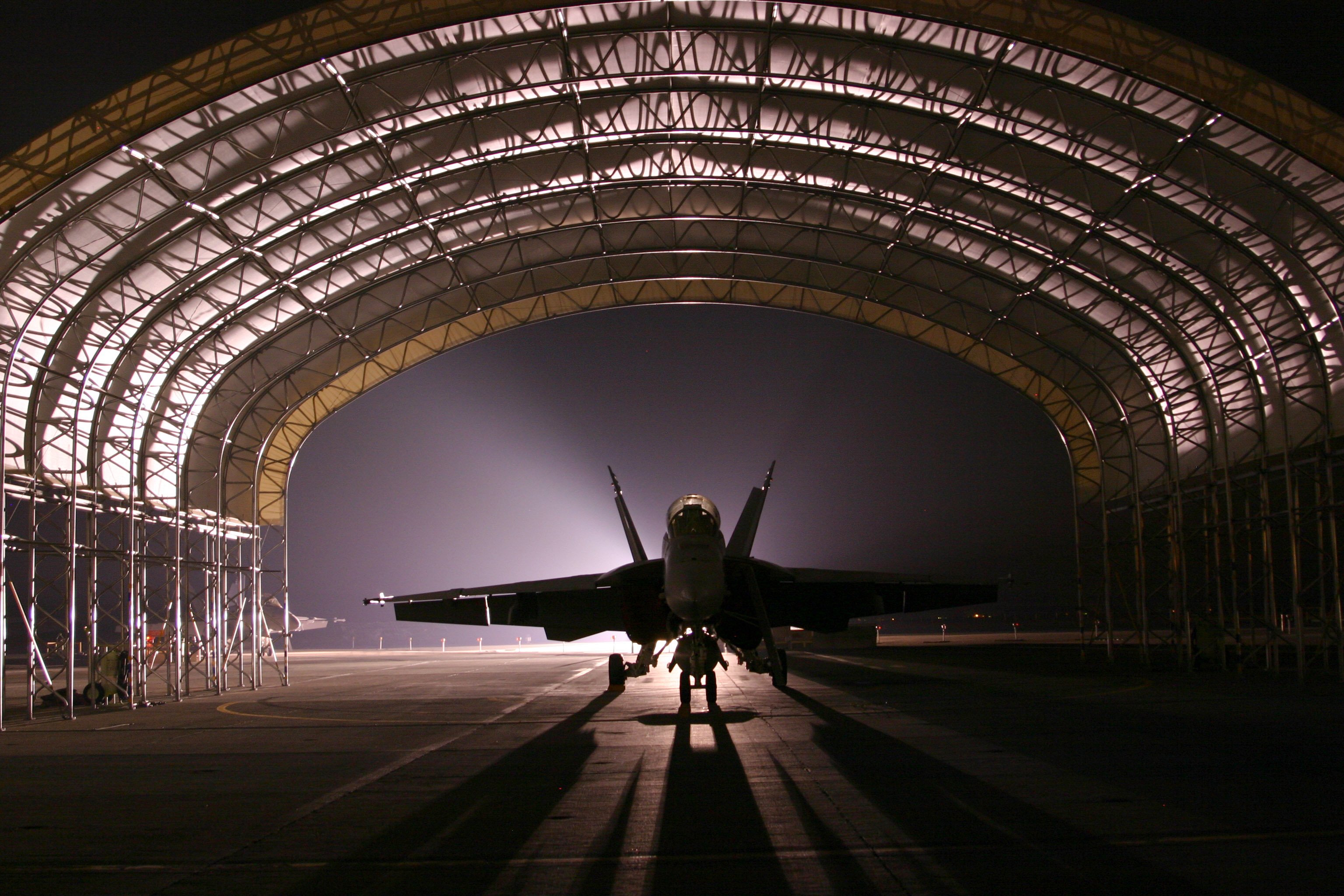
An F/A-18F attached to the “Flying Eagles” of Strike Fighter Squadron One Two Two (VFA-122), sits on the line at Naval Air Station (NAS) Lemoore, Calif., in December 2005. U.S. Navy photo.
The Navy and Marine Corps found that less experience in their aviation maintenance crews has contributed to a sharp rise in Class C mishaps – often taking place during aircraft towing or repair work – and are taking steps to reverse this trend.
The Navy has settled on a plan to double the length of some enlisted maintainers’ first shore tours, the Marine Corps has revamped its maintainer training and retention and aircraft towing policies, and both services are working together to make better use of near-miss data to find trends and avoid future mishaps before they happen.
Rear Adm. Roy Kelley, commander of Naval Air Forces Atlantic, said Class C mishaps, which involve $50,000 to $500,000 in damages to aircraft or a nonfatal injury, have doubled in the Navy since 2012.
“We have determined from the Naval Safety Center and the Center for Naval Analyses damage sustained during maintenance is the leading cause of these mishaps, with the analysis pointing towards maintainers that are less experienced,” Kelley said late Thursday afternoon during his opening statement in a hearing of the House Armed Services readiness subcommittee.
“The reduced experience is being addressed by doubling the length of orders for shore-based apprentice maintainers from two to four years, enabling them to gain additional experience and qualifications.”
Kelley told reporters after the hearing that two-thirds of the Class C mishaps were related to maintenance. According to written testimony from a previous House Armed Services Committee hearing on aviation safety, from Fiscal Year 2008 to FY 2017, the Navy’s Class C mishap rate rose from about seven and a half per 100,000 flight hours to about 22 mishaps per 100,000 flight hours. For the Marine Corps in that same time period, Class C mishaps rose from about 10 to about 27 per 100,000 flight hours, according to the document.
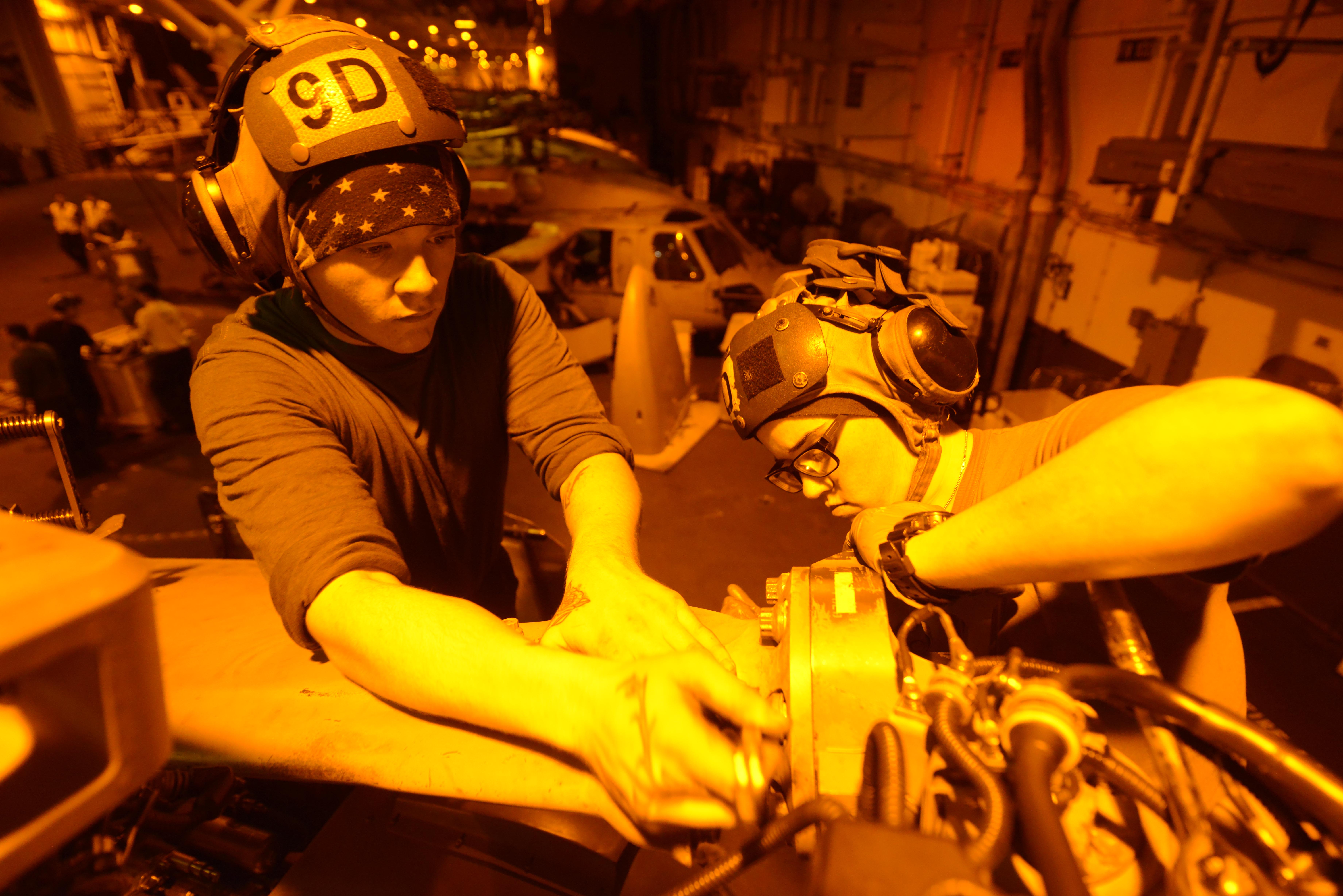
Aviation Machinist’s Mate 3rd Class Noah Walker, left, and Aviation Machinist’s Mate 2nd Class Ashley Tjon, both assigned to the “Dragon Slayers” of Helicopter Sea Combat Squadron (HSC) 11, performs maintenance on an MH-60S Sea Hawk helicopter in the hangar bay of the Nimitz-class aircraft carrier USS Harry S. Truman (CVN 75). US Navy photo.
To stop the trend, Kelley said the Navy wants to get enlisted maintainers more experience at the very beginning of their careers, and then help ensure that their expertise is put to best use in their later assignments.
“The difference in the enlisted experience that we have in E-5s, E-6s, is about a year and a half short of what it used to be 10 years ago. So to give you an example, if you had an E-6 that 10 years ago in the same timeframe in their career had 11-and-a-half years of experience, today they would have 10 years,” the admiral said.
“So that difference. Also the fact that we have people that are being assigned, they have helicopter backgrounds and they’re going to F-18 squadrons or vice versa. We’re now clarifying specific qualifications at the Bureau of Naval Personnel through this AMEX (Aviation Maintenance Experience Management) program … It’s not just a matter of what is their rate, as in an AD, an aviation mechanic on an engine – it goes through and talks about what qualifications that person has, and then we look at the squadron and say, what do they need? Well they need an AD-1 that has this particular qualification. So we can match them up and bring the experience levels they need in the squadrons.”
Kelley said a pilot program called AMEX 1 has already taken place, with AMEX 2 coming up to continue testing the experience management tool. The pilot program is taking place at Naval Air Station Lemoore because that is a primary place that aircraft maintainers would go if their first tour was a shore duty.
“Usually we try to send them to sea first, but if it’s a shore-based tour then we try to make it short. That’s why it was two years. As a result, they were being assigned to locations like (Strike Fighter Squadron) VFA-122, the training squadron there in Lemoore, and to AIMD, our maintenance depot that’s located there. They weren’t getting experience (in just two years), and then we were sending them out to sea. So we said, if you really want to get use of those people, give them two more years so … you’ve got a more experienced sailor now in the next unit they go to at sea,” Kelley added, explaining the move from a two-year tour to a four-year tour for aviation maintenance apprentices in their first assignment.
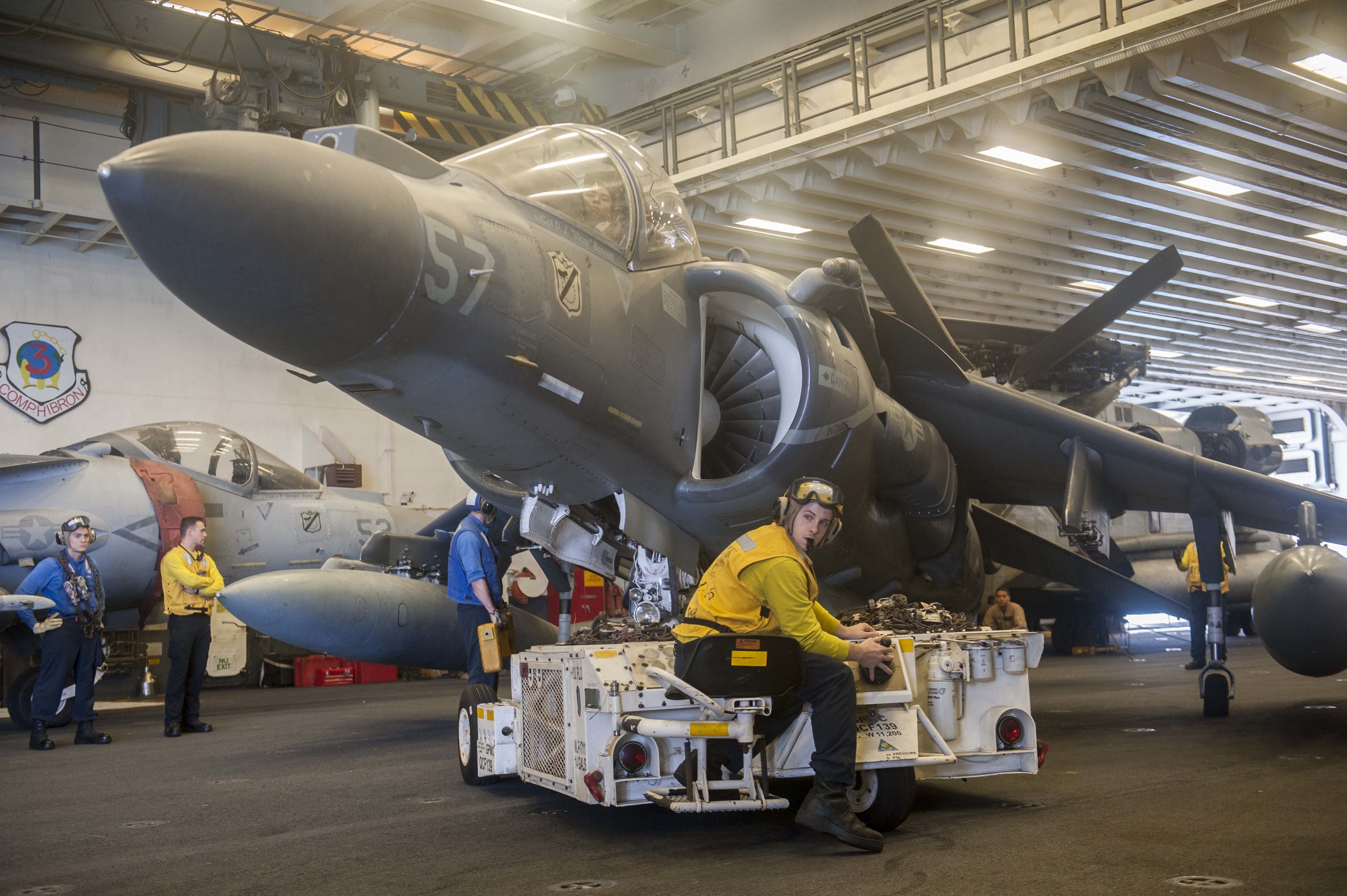
Aviation Boatswain’s Mate 3rd Class Jacob Margraves, assigned to the air department aboard the amphibious assault ship USS America (LHA 6), tows an AV-8B Harrier assigned to Marine Medium Tiltrotor Squadron (VMM) 161 (Reinforced) using a towing dolly in the hangar bay. US Navy photo.
On the Marine Corps side, Deputy Commandant for Aviation Lt. Gen. Steven Rudder said FY 2017 was a tough year for the Marines when it came to Class A mishaps, or those that involve a fatality or loss of an aircraft. Each of the 12 Class A incidents was unique, he said – including one aircraft maintainer who was struck by lightning and died – and so drawing broad conclusions is tough. On the Class C mishaps, though, he also pointed to inexperience among the enlisted maintainers.
Rudder said the bulk of the Class C mishaps occurred when “young Marines trying to do the right things” ended up “towing very expensive airplanes into things. So we’ve revamped our whole towing policy – most of these happen during night crew, which to most is when most of the work gets done for the next day’s schedule – and we’ve increased the level of expertise and [non-commissioned officer] leadership to our night crews.”
Additionally, he told reporters after the hearing, “one of the ways that we’ve found has been helpful in retention is rewarding those that have achieved higher level qualifications on working on that airplane. So in the Marine Corps we promote if you can shoot well, you can run, you are in shape, and you’re smart. In aviation maintenance, we would like to reward people that can do all those things as well as be a professional, qualified mechanic on an F-35 or V-22. And so we gave them recently, last year we gave them an additional [military occupational specialty] and when they went to reenlist, if they did re-enlist, we gave them a bonus kicker for reenlisting. And part of that reenlistment was, you get that $20,000 and we kept you in a squadron for another two years, you didn’t go anywhere else.”
He clarified that those maintainers would either stay in their same squadron or move to another similar operational squadron, but the focus would be on keeping their skill set in the operational and deployable fleet to support Marine aviation.
Regarding Class A mishaps, Rudder said during his opening statement that, “despite the fact that we are well within our normal rates for the 10-year average, [Fiscal Year 2017] was not good and it has our full attention.” Of the 12 mishaps he spoke of, 20 percent occurred at sea, 40 percent occurred in an expeditionary environment, and 60 percent occurred during a deployment. Two of the Class A mishaps occurred on the ground: the fatal lightning strike, and a flash fire incident that injured two Marines.
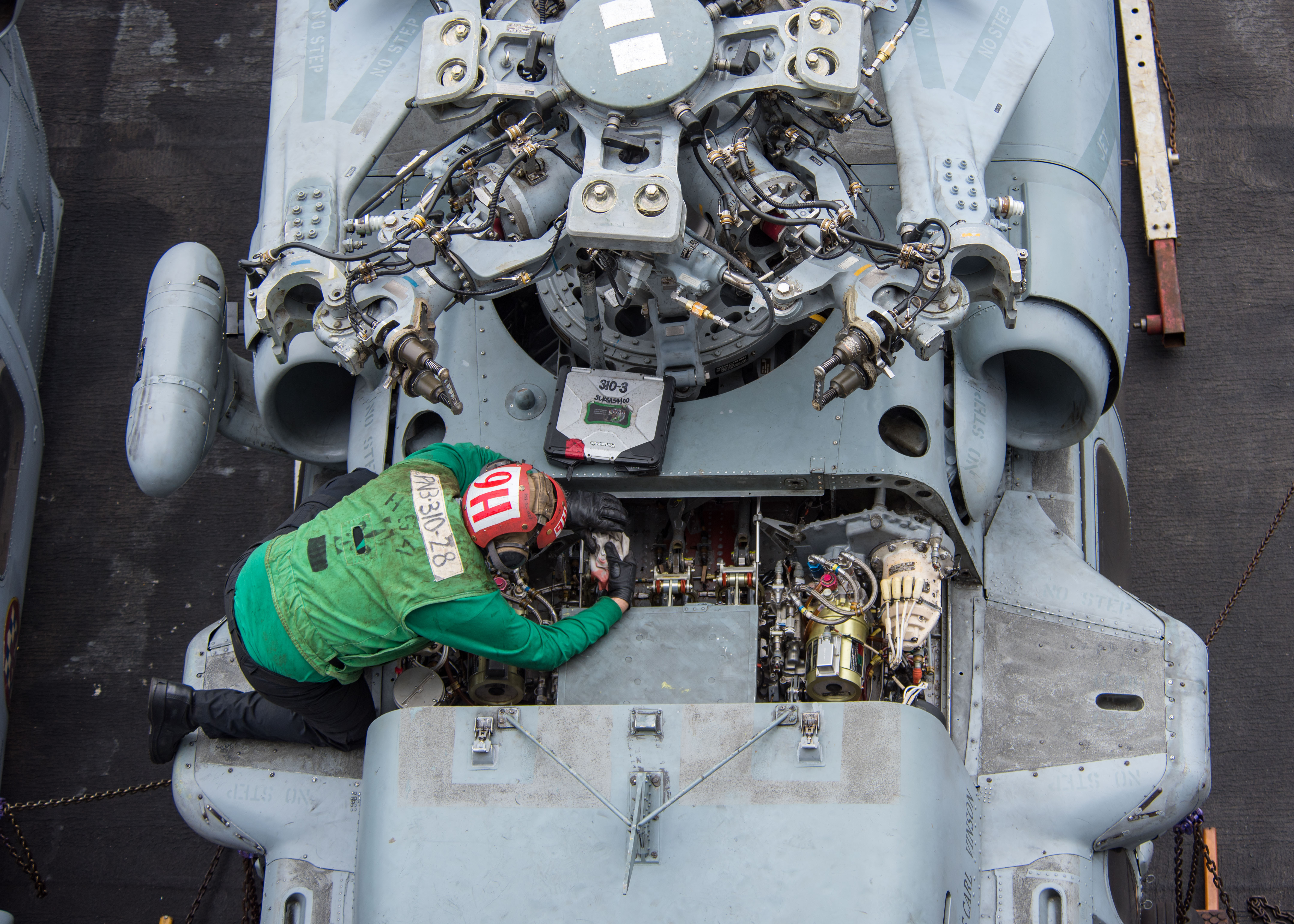
A Sailor assigned to the Black Knights of Helicopter Sea Combat Squadron (HSC) 4 conducts maintenance on an MH-60S Sea Hawk helicopter on the flight deck of Nimitz-class aircraft carrier USS Carl Vinson (CVN 70). US Navy photo.
Though there were not common themes among the dozen Class A incidents, Rudder assured the subcommittee that each and every one was investigated and led to corrective actions.
When a KC-130T crashed and killed 15 Marines and a Navy hospital corpsman, it was unclear what caused the crash, since a C-130 hadn’t crashed in more than a decade, Rudder said. But the Marine Corps, out of an abundance of caution, grounded the remaining KC-130T squadron until the propellers on each of its 12 planes were replaced.
When a MV-22 Osprey crashed into the back of a ship off the coast of Australia and killed three Marines aboard, the Navy and Marine Corps reduced the allowable maximum weight and increased the required wind envelop for Ospreys landing on ships to create a greater power margin during landings, as USNI News previously reported.
When an Osprey crashed in a reduced visibility situation in an undisclosed location in U.S. Central Command, though the crew had been legally allowed to fly the aircraft in that situation, the Marine Corps decided to change its requirements to reflect those of the Air Force’s special operators, who require more training time in reduced visibility situations before allowing their pilots to land in the dirt or sand during operations.
“While there’s still no direct link between low readiness rates and causation to Class A mishap rates, we continue to believe a true metric of health of naval aviation is aircrew flight hours. Well trained, practiced aviators react to malfunctions and difficult circumstances far better and are much less likely to make mistakes, which in turn allow them to react in a fluid situation or unforeseen event.”
To that end, the Marine Corps is working hard to increase pilots’ monthly flight hours, especially for those not deployed or working up for an imminent deployment. The service considers 15 hours a month per pilot the safe level, and 16.9 hours the level for combat readiness. In 2016, Rudder said, pilots were averaging 13.5 hours a month; in 2017 that was up to 15.4 hours, and today the service sits at 17.2 hours. Though causation isn’t proven, Rudder noted that last year’s mishap rate was 3.99 mishaps per 100,000 flight hours, and today the Marine Corps sits at around 1.7, due to three Class A mishaps so far in FY 2018. Knock on wood, he said, the service is seeing not only more flight hours but safer operations this year.
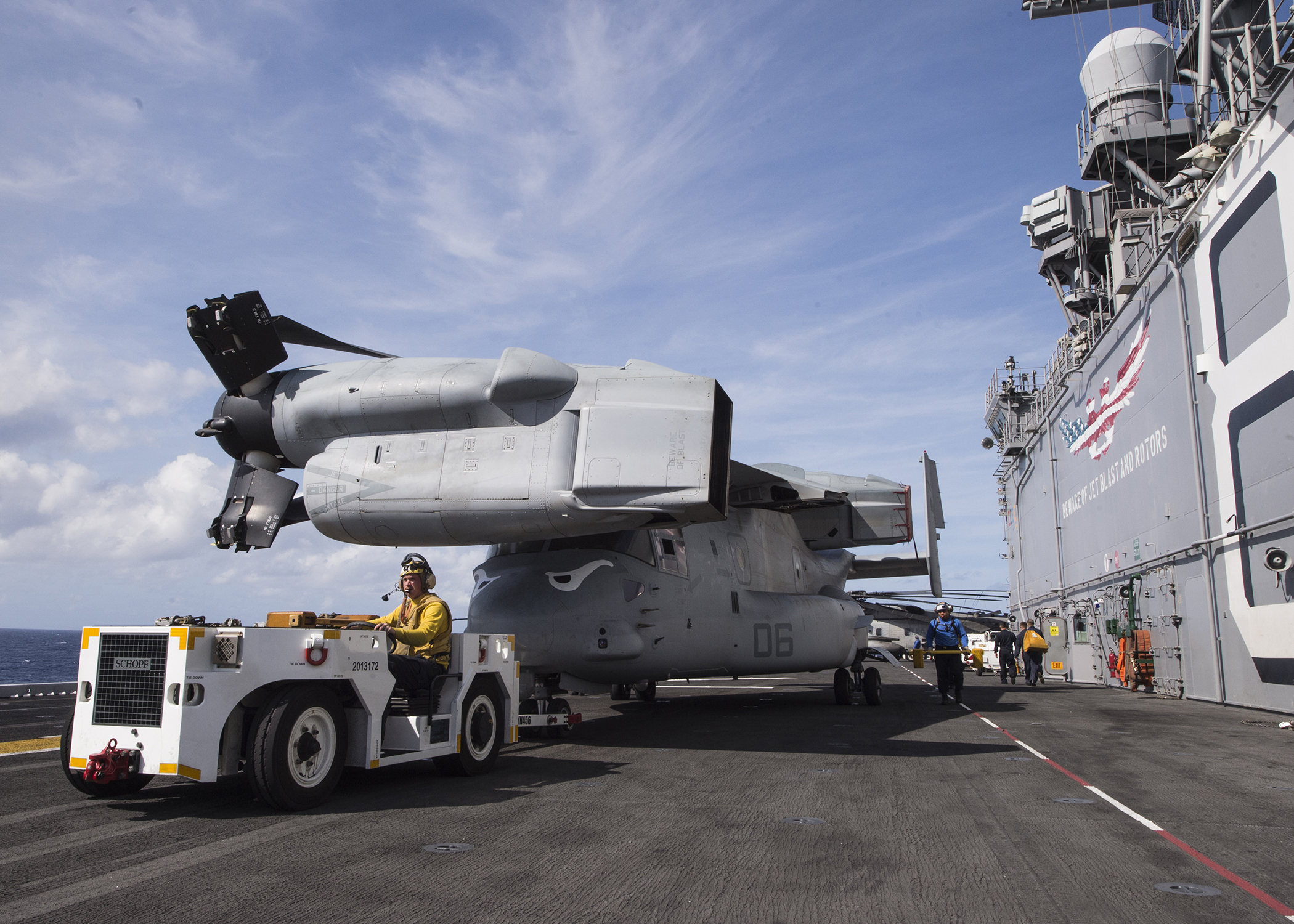
Petty Officer 3rd Class Willie Crosson drives an aircraft tow tractor to pull an MV-22 Osprey on the flight deck of the amphibious assault ship USS Makin Island (LHD 8). US Navy photo.
On the Navy side, Kelley said, it is clear that investments in readiness-builders like spare parts, maintenance and logistics are paying off. At NAS Lemoore, VFA-122, the fleet replacement squadron that teaches new fighter pilots how to fly tactical airplanes, only had six ready airplanes just five months ago. Last week, Kelley said, the squadron had 25 mission-capable planes for new pilots to fly.
“While a ready fleet is a lethal fleet, it must also be a safe fleet. Our goal is to have zero preventable mishaps. But for those that do occur, we rigorously investigate and disseminate the lessons learned to help prevent the mishap from happening again,” Kelley said.
To that end, the Navy and Marine Corps are investing in a new Aviation Safety Awareness Program that the Air Force currently uses that allows anonymous reporting of safety concerns and near-miss incidents. Rudder said they amount to a hotline for aviators to report anything from an increase in birds near a runway to potentially hazardous civilian traffic in military flight paths to unsafe behavior by colleagues. Squadrons’ safety officers can review the data, which is also passed up the chain and analyzed with data analytics tools to allow for trend analysis and more predictive analysis of safety issues.
